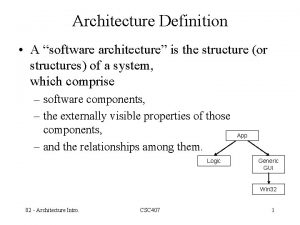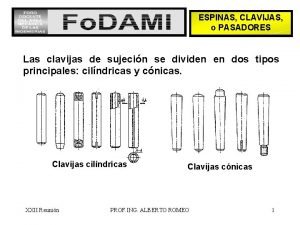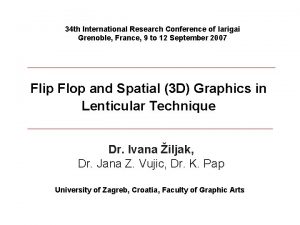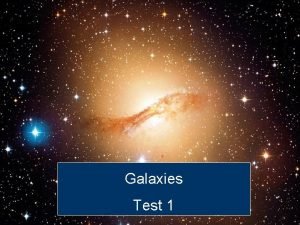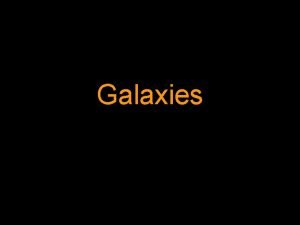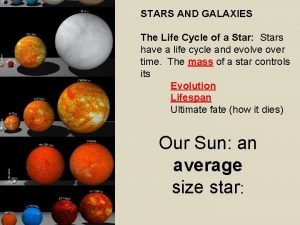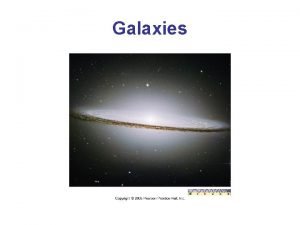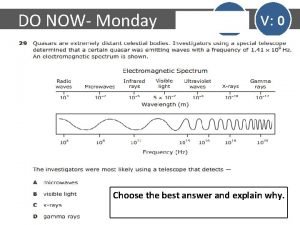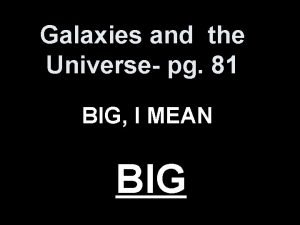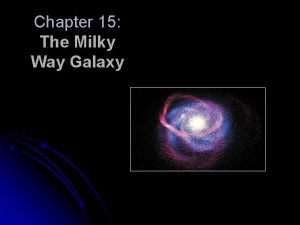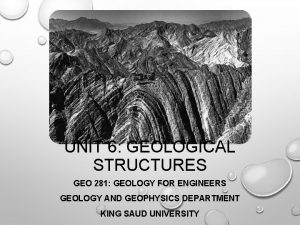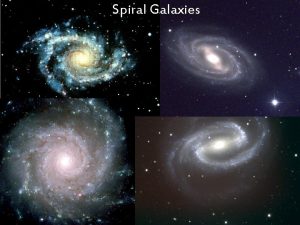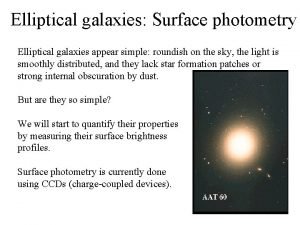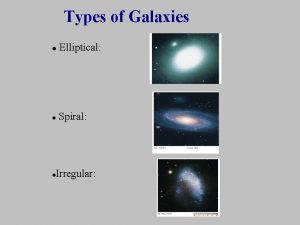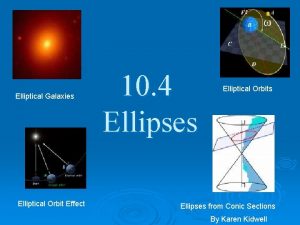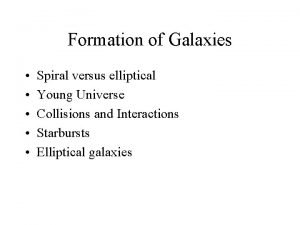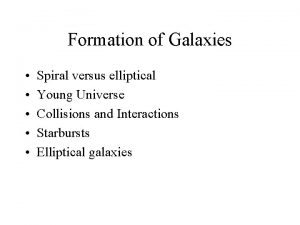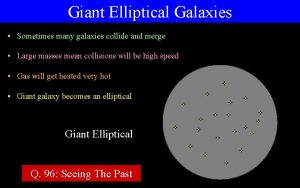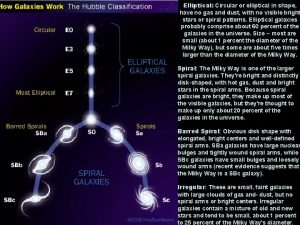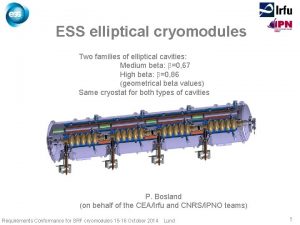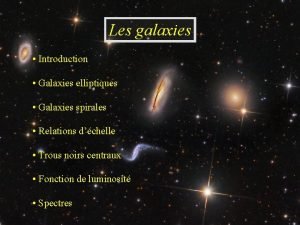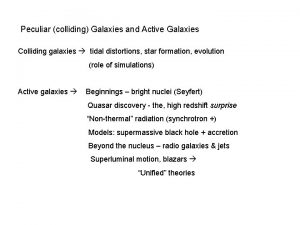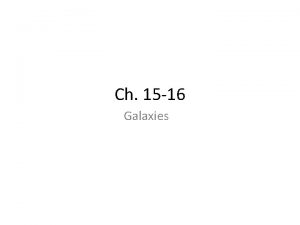GALAXIES TYPES OF GALAXIES Elliptical Lenticular Spiral 2



























- Slides: 27

GALAXIES

TYPES OF GALAXIES • Elliptical • Lenticular • Spiral (2 branches) • Irregular


Elliptical Galaxies • Elliptical galaxies are smooth and elliptical in appearance (E 0 -E 7) • Most common type of galaxy distinguishing characteristics of the ellipticals: (a)much more random star motion than orderly rotational motion (b) they have very little dust and gas left between the stars;

Elliptical Galaxies c) no new star formation occurring and no hot, bright, massive stars in them d) they have no spiral structure.

Messier 32: a dwarf elliptical (E 2)

Messier 87: giant elliptical (E 1)

Lentculars • A lenticular galaxy is an intermediate between an elliptical and a spiral galaxy (S 0) • Disc galaxies(like spiral galaxies) that have used up or lost most of their interstellar matter and therefore have very little ongoing star formation.


Spiral Galaxies • Spiral galaxies have flattened disks with a spiral pattern. • Normal Spirals (Sa, Sb, Sc, Sd) • Barred Spirals (SBa, SBb, SBc, SBd)


Spiral Galaxies distinguishing characteristics of the spirals are: a) they have more orderly, rotational motion than random motion (the rotation refers to the disk as a whole and means that the star orbits are closely confined to a narrow range of angles and are fairly circular); b) they have some or a lot of gas and dust between the stars;

(c) can have new star formation occurring in the disk, particularly in the spiral arms (d) they have a spiral structure.

Spiral Galaxies • sub-classified into ``a'', ``b'', ``c'', and ``d'' groups according to how loose their spiral arms are and how big the nucleus is. • The ``a'' group spirals have large bulges and very tightly wound spiral arms and the ``d'' group spirals have almost no bulge and very loose arms.

Spiral Galaxies • The Milky Way is between the ``b'' and ``c'' groups with a bar, so it is an SBbc-type spiral galaxy.

The Andromeda Galaxy (=M 31): a large spiral galaxy (Sb)

NGC 2997: a large spiral galaxy (Sc).


NGC 1365: a barred spiral galaxy (SBbc).

Irregular Galaxies • Irregular galaxies have no definite structure. • Classified as (Irr I, Irr II, dlrrs) • The stars are grouped in patches but are randomly distributed throughout the galaxy. • Some irregulars have a lot of dust and gas so star formation is possible.

Irregular Galaxies • Examples of irregular galaxies are the Large and Small Magellanic Clouds (two small irregulars that orbit the Milky Way).



COMMON GALAXIES GALAXY DESCRIPTION Milky Way Galaxy -contains Earth -named after the nebulosity in the night sky that marks the densest concentration of stars of our galaxy in the sky, which appears to blur together into a faint glow, called the Milky Way.

COMMON GALAXIES GALAXY DESCRIPTION Andromeda Commonly just Andromeda, this, called the Andromeda Galaxy, Andromeda Nebula, Great Andromeda Nebula, Andromeda Spiral Nebula, and such, has been traditionally called Andromeda, after the constellation in which it lies.

COMMON GALAXIES GALAXY DESCRIPTION Large Magellanic Cloud This is the fourth largest galaxy in the Local Group, and forms a pair with the SMC, and from recent research, may not be part of the Milky Way system of satellites at all. It is visible with the naked eye.

COMMON GALAXIES GALAXY DESCRIPTION Small Magellanic Cloud Recent research suggests that this galaxy may not be part of the Milky Way system of satellites at all. One of the four irregular galaxies
 Spiral elliptical and irregular
Spiral elliptical and irregular Elliptical galaxies facts
Elliptical galaxies facts Properties of elliptical galaxies
Properties of elliptical galaxies Tabel panjang lengkung peralihan
Tabel panjang lengkung peralihan What is software structure
What is software structure Astigmatisml
Astigmatisml Hipodensidad en radiografia
Hipodensidad en radiografia Las chavetas trabajan al corte y al aplastamiento
Las chavetas trabajan al corte y al aplastamiento Lentiform nucleus
Lentiform nucleus Lenticular printing vancouver
Lenticular printing vancouver 4 types of galaxies
4 types of galaxies Types of galaxies
Types of galaxies Waves are produced by stars and galaxies.
Waves are produced by stars and galaxies. Life cycle of galaxies
Life cycle of galaxies E irregulars
E irregulars The pity relation for an adiabatic expansion is
The pity relation for an adiabatic expansion is Milky way galaxy shape
Milky way galaxy shape Chapter 30 galaxies and the universe
Chapter 30 galaxies and the universe Brainpop galaxies quiz answers
Brainpop galaxies quiz answers How are galaxies classified? *
How are galaxies classified? * Tipus de galaxies
Tipus de galaxies Evolution of galaxies
Evolution of galaxies Billions of galaxies
Billions of galaxies Galaxies lesson plan
Galaxies lesson plan Advantages of egg shaped sewer
Advantages of egg shaped sewer Geo 281
Geo 281 Verb acting as an adjective
Verb acting as an adjective What is an elliptical clause
What is an elliptical clause




